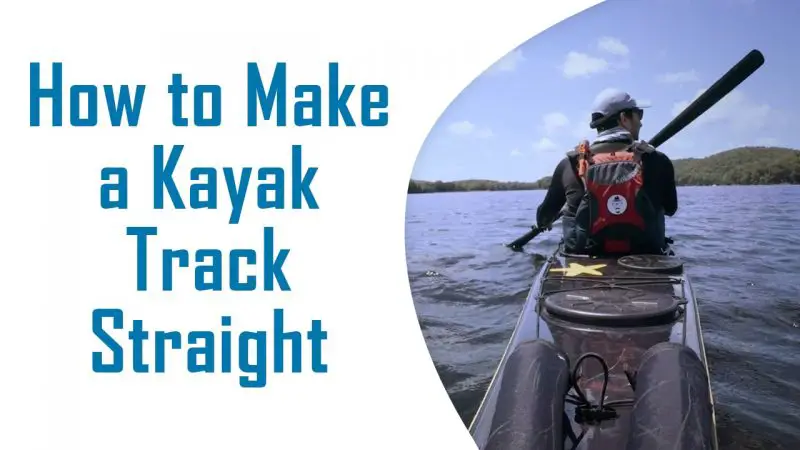The real fun of kayaking comes if you know how to make a kayak track straight with good maneuverability. Isn’t it? And the best way to keep a kayak going straight is using a skeg or rudder to keep your kayak follow your track.
Of course, there are some other ways you can try out. As a kayaking freak team, after so much research and adventurous kayaking weekends, we have been able to figure out some effective methods that we thought of sharing with you will be helpful.
And yes, there will be some precautionary tips also for the best kayaking experience ever. Let’s dive in.
What Is Kayak Tracking?
Initially, we should have a concept of kayak tracks. In the dictionary of kayak riding, the word ‘tracking’ refers to the vessel control settings. That means, it is the habitual course of a kayak at times of dislocation and movement changing.
In addition, tracking means the steering activity of a boat, which ensures the overall straight-lined direction.
Several issues come across during the tracking of a kayak. And, these factors often enhance the difficulty level for the vessel paddlers by arising problematic turns. Thus, the speed of water waves, wind direction, and lousy size of paddles work against proper tracking.
However, the size and length of the kayak hull along with a rudder or skeg mainly play a vital part in tracking.
Importance Of Kayak Tracking In A Straight Way
As a beginner in this field, you often wonder about how to make a kayak track straight. Nevertheless, it is crucial to discover the importance of kayak tracking first. Here are some noteworthy facts for you.
- You may have questions about how to paddle a kayak in a straight line but naturally, the yachts with high-quality tracking aptitude generate the paddling system to flow in a straight line. Furthermore, that is also with less effort from the paddlers.
- The stormy weather structure often requires kayak tracking in a straight manner. Moreover, when the left and right force becomes even, the rider’s paddling technique does not work and that time you need to learn “why does my kayak keep turning.” As a result, turning energy from the wind can cause accidents. So, it is better to apply the tracking method to keep the resistance of the canoe.
Therefore, to sum up, the better tracking ability of any vessel decreases the risk of accidentally turning it upside down.
How To Make A Kayak Track Straight
Eventually, we have reached your most awaited part, which is ‘how to make a kayak track straight.’ Here are some useful instructions for the riders. However, these steps should be followed under expert supervision.
Method 1: Use Rudder Or Skeg For Proper Tracking
Generally, crosswinds are responsible for unusual boat maneuvers. Moreover, beam seas do not allow the paddler to make straight tracking.
However, in that case, a rudder or skeg can solve the problem partially. So, install the skeg or rudder when backwinds try to take control of the kayak from the rear side. These tools provide support to control the problematic kayak’s tendency.
First, you need to employ the rudder (or skeg) in exchange for the paddle stroke. To clarify, for the right-sided speedy waves, move forward the right rudder pedal. Then, drive or paddle it to the left side.
Also, do not give much attention to the unnecessary rudder movements. Otherwise, it can pull your kayak down.
 Borogo 8 inch Detachable Center Fin, Kayak Skeg
Borogo 8 inch Detachable Center Fin, Kayak Skeg
- Suitable for different models
- Easy to assemble
- 365-day limited manufacturer warranty
Borogo Kayak Rudder
- Designed for seayak, kayak, canoe, angling boat, etc
- Work with foot control
- Gain control of your kayak in windy or turbulent conditions
Method 2: Regulate The Vessel Fin
To handle the kayak tracking issues, you should pay a specific concentration in the fin adjusting process. Alter the fin position from the upside to the downside until you get a hold of the straight kayak route. However, ignore the unsteady mode of the waves from time to time.
Method 3: Supervise The Equipment Structure Properly
Whether you use a rudder, skeg, or fin, the total system maintenance should be up-to-date.
Sands, soil, or rough gravels can create disturbance in the fin activities. So, you should check and clean the catch regularly. Moreover, rudders and skeg should be washed to reduce user damage.
Method 4: Choose Accurate Size For The Paddle
Always try to select the appropriate size for your paddle. In the beginning, most novice paddlers start their journey with a giant-sized paddle and don’t even know how to paddle a kayak straight. Thus, they make further tasks complicated.
The expert kayakers recommend a comparatively short paddle to start kayak tracks. By standard rule, the shorter size of your paddle enables you to track straight more comfortably.
Usually, 210-220 cm length of the paddle is enough for a kayak within 25 inches of width. Thus, it ensures a trouble-free ride most of the time.
Method 5: Catch Up Your Daily Practice
Sometimes a damaged vessel can create a mess and does not allow you to straighten your waterways. Nevertheless, that is an infrequent event indeed. Besides, the kayak types can affect the tracking somehow, but the overall experience of the kayakers matters hugely.
Hence, there is no alternative to continuous practice with a focused mind.
Some Useful Tips And Precautionary Reminders
Even after applying the above techniques, things can go wrong at any time. However, a systematic approach to paddle your kayak straight can trim down the trouble. Remember that it takes almost a couple of sessions to maintain a straight track for kayaking.
Now, check out the following list to get some pro ideas.
- Ensure appropriate seating position at times of paddling. Typically, a straight or slightly forward posture works well.
- Take additional care in case of using a kayak skeg placement instead of a rudder. The operating system and tool position of the skeg is different from the rudder.
- Try to create a stroke with an increased angle form. Moreover, it is better to put the blade beside the kayak.
- Do not depend too much on the rudder, skeg, or fin. Perform kayak tracking without using these tools in your practice session to explore how to make a kayak track straight.
Wrap Up
To be an expert in kayak tracking, continuous efforts, and practice under professional guidance are necessary. Additionally, the more you practice; you will be able to deal with unexpected events during your journey and will understand how to keep kayak straight or how to make your kayak track better and better over time going.
Therefore, you just need to expertise yourself and achieve knowledge on how to make a kayak track straight. We hope you will be benefitted from this feature and successfully figure out the imperfections of your paddling style.
- How To Fit 3 Kayaks On A Car | Several Effective Ways
- How to Use J Hooks For Kayak – A Complete Guideline
- How To Cane A Canoe Seat | Materials, Making Process, Tips
- Essential Things Of How To Launch A Kayak At A Boat Ramp
- How to Secure Kayaks Outside – When Have No Place to Store Indoors
- Trolling Motor Vs Gas Motor – Select the Appropriate Motor for Your Boat
- Best Underwater Dock Lights – 5 Best Picks to Embellish Your Dock
- The 5 Best Underwater Transom Light – To Conquer the Darkness in Water

